Have you ever wondered about the role of horseback riding in therapy programs? It may seem like an unconventional form of therapy, but many people swear by its effectiveness. In this article, we’ll explore the various ways in which horseback riding can be beneficial for individuals with physical, emotional, or cognitive challenges. Whether you’re curious about equine-assisted therapy for children with autism or want to learn more about therapeutic riding for individuals with physical disabilities, we’ve got you covered. So, saddle up and get ready to delve into the world of horseback riding therapy!
Horseback riding therapy programs, also known as hippotherapy, utilize the unique movements of horses to help individuals improve their motor skills, balance, and coordination. The rhythmic motion of riding a horse mimics the natural movement of walking, which can be incredibly beneficial for individuals with physical challenges. Additionally, interacting with horses can have a profound impact on one’s emotional wellbeing. The bond between human and horse is a powerful one, and many people find solace and comfort in the presence of these magnificent creatures. In our upcoming blog posts, we’ll dive deeper into specific therapy programs and explore the research and testimonies that support the effectiveness of horseback riding in improving quality of life. Stay tuned for a fascinating journey into the world of horseback riding therapy!
The Role of Horseback Riding in Therapy Programs
Understanding Horseback Riding as a Therapy
Horseback riding therapy, also known as equine therapy, is a unique form of therapy that utilizes horses to assist individuals in achieving physical, psychological, and cognitive improvements. This therapy has gained popularity due to its effectiveness in treating various conditions and disorders. In this article, we will delve into the history, benefits, types, and integration of horseback riding therapy with other modalities.
What is Equine Therapy?
Equine therapy involves horse-assisted activities and therapy programs that focus on utilizing interactions with horses to promote emotional growth, physical development, and cognitive functioning. It is a holistic approach to therapy that combines the benefits of physical activity, animal-assisted therapy, and the connection between humans and horses.
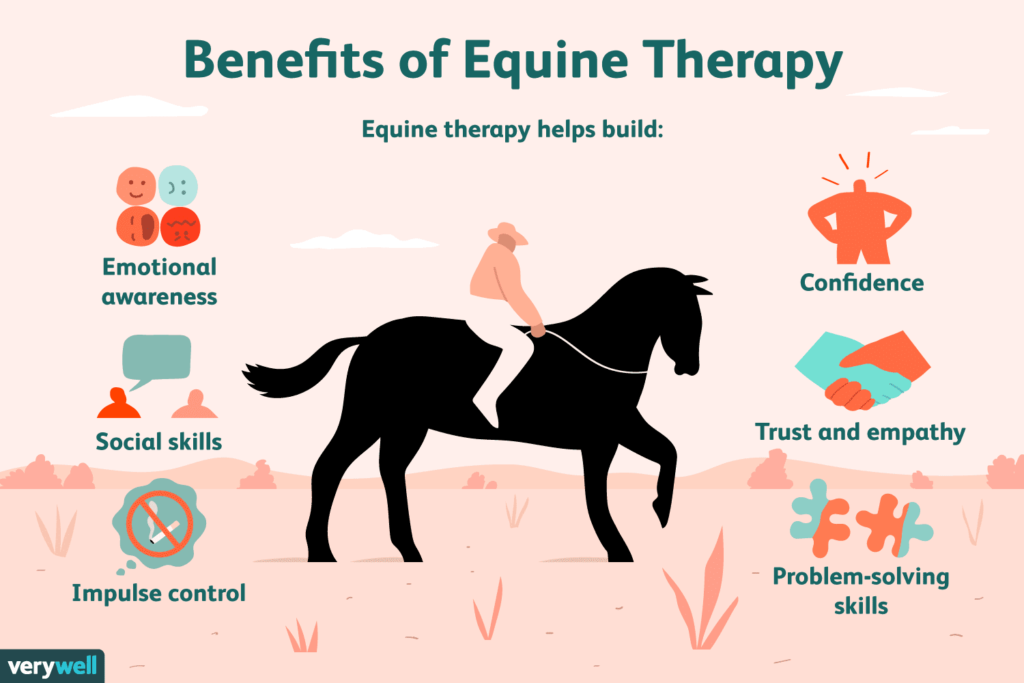
History and Development of Horseback Riding Therapy
The use of horses in therapy can be traced back to ancient civilizations such as the Greeks and Persians, who recognized the healing properties of horseback riding. However, it was during the mid-20th century that horseback riding therapy began to be recognized as a formal therapeutic approach. The development of this therapy can be credited to the efforts of Liz Hartel, a Danish equestrian who won a silver medal in dressage at the 1952 Summer Olympics despite being paralyzed from the knees down. Her success inspired the establishment of therapy programs around the world.
Benefits of Horseback Riding Therapy
Horseback riding therapy offers a wide range of physical, psychological, and cognitive benefits. Let’s explore each category in detail:
Physical Benefits of Horseback Riding Therapy
Improvement in Balance and Coordination
Horseback riding requires the rider to engage their core muscles to maintain balance. The rhythmic movement of the horse stimulates the vestibular system, improving coordination and balance in individuals with physical disabilities or neurological conditions.
Enhancement of Muscle Strength and Endurance
The act of riding a horse activates and strengthens various muscle groups, including the legs, arms, and core. Regular horseback riding therapy sessions can lead to increased muscle strength and endurance in participants.
Promotion of Flexibility and Joint Mobility
The cyclical motion of the horse’s gait promotes flexibility and joint mobility. This is particularly beneficial for individuals with conditions such as cerebral palsy or arthritis, as it helps improve range of motion and reduce stiffness.
Development of Core Stability
Maintaining balance and posture while riding a horse requires a strong core. Horseback riding therapy helps individuals develop core stability, which can improve their overall movement and stability in daily activities.
Psychological and Emotional Benefits of Horseback Riding Therapy
Reduction of Stress and Anxiety
Interacting with horses has been found to have a calming effect on individuals, reducing stress and anxiety. The rhythmic motion of the horse and the bond formed between the rider and the horse can provide a therapeutic escape from the stresses of everyday life.
Improvement in Mood and Self-esteem
The sense of accomplishment that comes from mastering horseback riding skills can greatly enhance mood and self-esteem. Participants experience a boost in confidence and a sense of empowerment, leading to improved overall well-being.
Boosting Confidence and Independence
Horseback riding therapy encourages participants to take charge of their actions and make independent decisions. This promotes confidence and a sense of control over their own lives.
Encouraging Trust and Emotional Connections
Building a bond with a horse requires trust and mutual respect. Horseback riding therapy helps individuals develop trust and establish meaningful emotional connections, which can have a positive impact on their interpersonal relationships.
Cognitive Benefits of Horseback Riding Therapy
Enhancement in Cognitive Functioning
The dynamic nature of horseback riding engages various cognitive processes, including attention, memory, and executive functioning. These cognitive demands stimulate brain activity and can enhance overall cognitive functioning.
Improvement in Attention and Focus
Maintaining control and focus while riding a horse requires individuals to pay attention to cues from the horse and their environment. This improves attention and concentration skills, which can be beneficial for individuals with attention deficit disorders or cognitive impairments.
Stimulation of Problem-solving and Decision Making
Interacting with a horse presents individuals with opportunities to make decisions and solve problems. This stimulates problem-solving and decision-making skills, promoting cognitive growth and development.
Promotion of Sensory Integration
Horseback riding therapy provides sensory stimulation through the tactile, auditory, and proprioceptive feedback received from the horse. This sensory integration can help individuals with sensory processing disorders improve their ability to process and respond to sensory information.
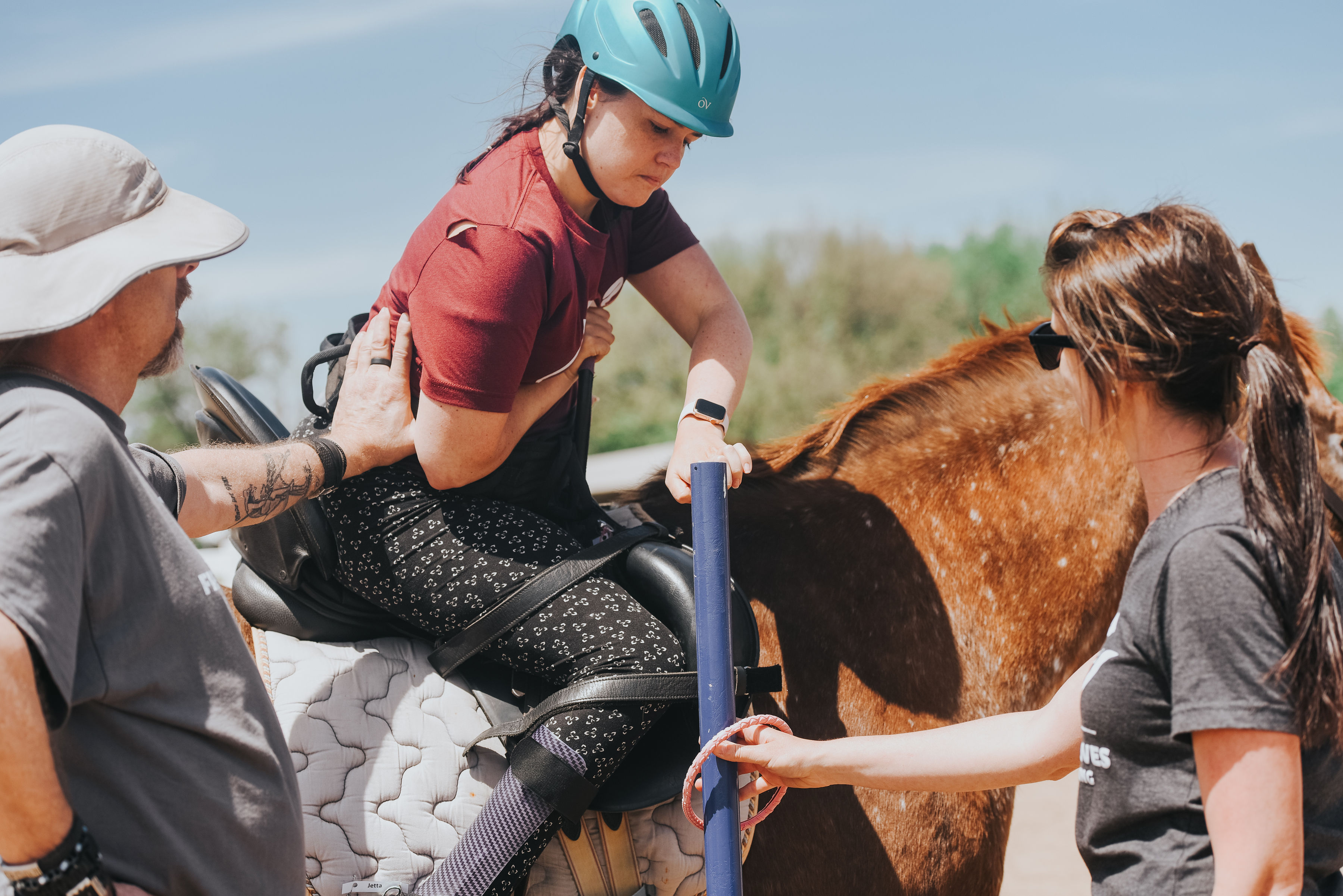
Conditions and Disorders Treated through Horseback Riding Therapy
Horseback riding therapy has been proven effective in treating various conditions and disorders. Let’s explore some of the commonly treated conditions:
Physical Disabilities
Horseback riding therapy can benefit individuals with physical disabilities such as cerebral palsy, muscular dystrophy, spinal cord injuries, and amputations. The rhythmic movements of the horse and the activation of muscles promote physical development and improve mobility.
Neurological Conditions
Individuals with neurological conditions such as multiple sclerosis, Parkinson’s disease, and stroke can experience improvements in motor skills, balance, and coordination through horseback riding therapy. The repetitive movements of the horse facilitate neural pathways and enhance neurological functioning.
Developmental Disorders
Children and adults with developmental disorders like autism spectrum disorder and Down syndrome can benefit from horseback riding therapy. The connection formed with the horse and the sensory input received during the therapy sessions can improve social skills, sensory processing, and overall development.
Mental Health Issues
Horseback riding therapy has shown positive results in individuals with mental health issues such as anxiety, depression, and post-traumatic stress disorder. The calming effect of interacting with horses and the sense of control gained from riding can alleviate symptoms and improve mental well-being.
How Horseback Riding Therapy Works
To understand how horseback riding therapy works, let’s explore the key components and processes involved:
Equine-Assisted Activities vs. Equine-Assisted Therapy
Equine-assisted activities focus on recreational and educational interactions with horses, whereas equine-assisted therapy is a more structured approach that involves specific therapeutic goals and interventions. Both approaches can be beneficial, depending on the individual’s needs and objectives.
Qualified Professionals in Horseback Riding Therapy
Horseback riding therapy should be conducted by professionals who have received specialized training and certification in equine-assisted therapy. These professionals, such as certified therapeutic riding instructors or licensed therapists, possess the knowledge and skills required to design and implement effective therapy programs.
Assessment and Goal Setting
Before starting horseback riding therapy, an initial assessment is conducted to evaluate the individual’s abilities, goals, and any potential limitations or contraindications. Based on the assessment, therapeutic goals are defined and a tailored treatment plan is developed.
Implementing Therapeutic Techniques on Horseback
Therapeutic techniques can include a combination of mounted exercises, dismounted activities, and interactions with the horse. These techniques are designed to target specific therapeutic goals and can involve exercises to improve balance, coordination, strength, emotional regulation, communication skills, and more.
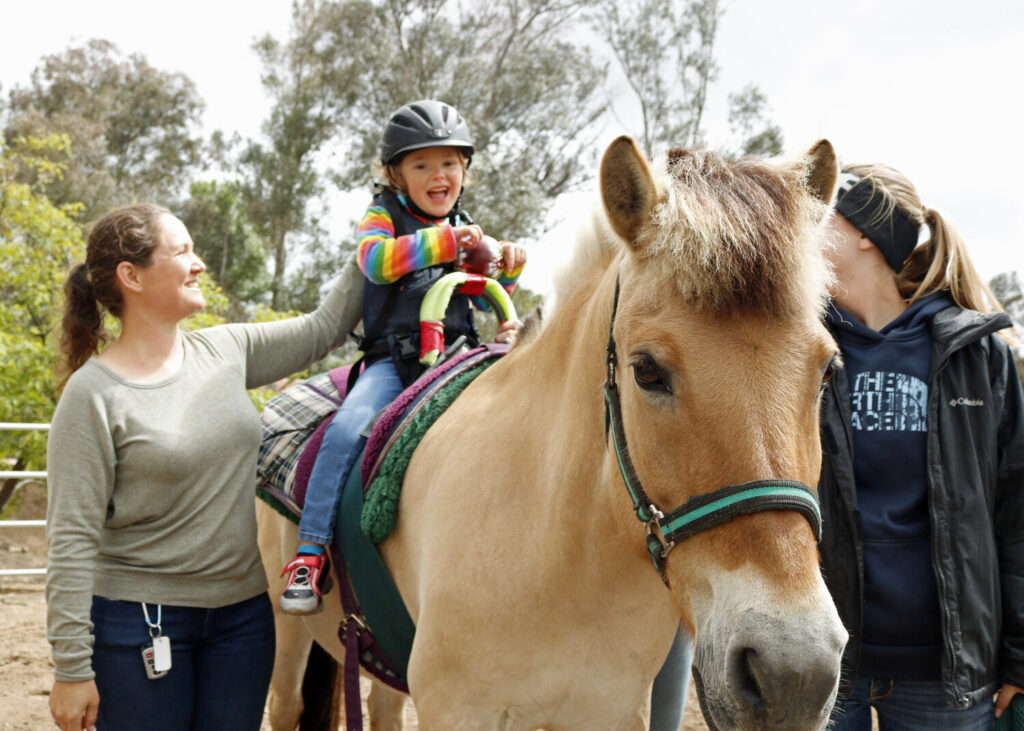
Safety Considerations and Precautions in Horseback Riding Therapy
Ensuring the safety of participants is of utmost importance in horseback riding therapy. Here are some key safety considerations and precautions:
Horse Selection and Training
Therapy horses should be carefully selected based on their temperament, training, and suitability for the participants’ needs. These horses should undergo regular training and evaluation to ensure their suitability for therapy sessions.
Rider Safety Measures
Participants are provided with appropriate safety gear, including helmets and protective vests. Trained personnel supervise the therapy sessions to ensure the safety of the riders and horses.
Equipment and Gear
Well-maintained and properly fitting equipment, such as saddles, bridles, and stirrups, are used during the therapy sessions. Regular inspections and maintenance of the equipment are carried out to ensure their safety and functionality.
Monitoring and Supervision
Close monitoring and supervision of participants during therapy sessions are essential to address any potential risks or concerns. Trained professionals should be present at all times to guide and assist participants as needed.
Role of Horses in Therapy Programs
Horses play a vital role in therapy programs and act as partners in the healing process. Let’s explore their significance:
Selection and Training of Therapy Horses
Therapy horses are selected based on their temperament, movement, and suitability for the participants’ needs. These horses undergo specialized training to ensure they can safely and effectively support individuals during therapy sessions.
The Connection between Horses and Humans
The bond formed between humans and horses is a unique and powerful connection. Horses are highly perceptive animals that can sense and respond to human emotions, creating a safe and non-judgmental environment for therapy.
Therapeutic Bond and Empathy
Horses have a natural ability to empathize with humans and respond to their emotional state. This therapeutic bond between the horse and the rider can help individuals build trust, develop empathy, and strengthen their emotional well-being.
Horses as Mirrors of Emotional States
Horses are known to reflect human emotions and provide valuable feedback. Their sensitivity to body language and non-verbal cues allows them to mirror the emotional states of participants, enabling self-awareness and emotional growth.
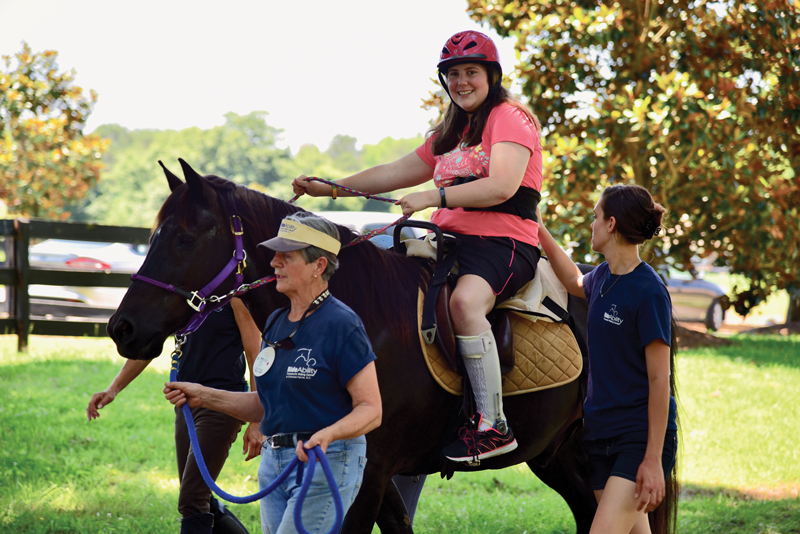
Success Stories of Horseback Riding Therapy
The impact of horseback riding therapy on participants’ lives is evident through numerous success stories and testimonials. Let’s explore some of the positive outcomes:
Case Studies and Testimonials
Case studies and testimonials showcase the transformative power of horseback riding therapy. They highlight the progress and achievements of individuals who have experienced significant improvements in various aspects of their lives.
Impact on Participants’ Lives
Horseback riding therapy has been known to improve physical functioning, enhance emotional well-being, foster personal growth, and promote independence. Participants often report an increase in confidence, social skills, and overall quality of life.
Personal Growth and Achievements
Participants in horseback riding therapy often experience personal growth and accomplishments. Overcoming challenges, mastering new skills, and achieving therapy goals contribute to their sense of achievement and self-worth.
Long-Term Benefits and Maintenance
The benefits of horseback riding therapy can extend beyond the therapy sessions. Participants are encouraged to incorporate the lessons learned and skills gained into their daily lives, ensuring long-term maintenance of the improvements achieved.
Integration of Horseback Riding Therapy with Other Modalities
Horseback riding therapy can be integrated with other therapeutic modalities to enhance the overall treatment approach. Here are a few examples:
Occupational Therapy
The combination of horseback riding therapy with occupational therapy can address specific functional goals, such as improving fine motor skills, coordination, and sensory integration.
Physical Therapy
Horseback riding therapy can complement physical therapy by providing a dynamic and interactive means of improving motor skills, balance, strength, and coordination.
Speech Therapy
Speech therapy can be incorporated into horseback riding therapy through activities that promote communication, language development, and social interaction.
Play and Recreational Therapy
The recreational aspect of horseback riding therapy can align with play therapy and recreational therapy, providing a fun and engaging therapeutic experience that promotes social skills, problem-solving, and emotional well-being.
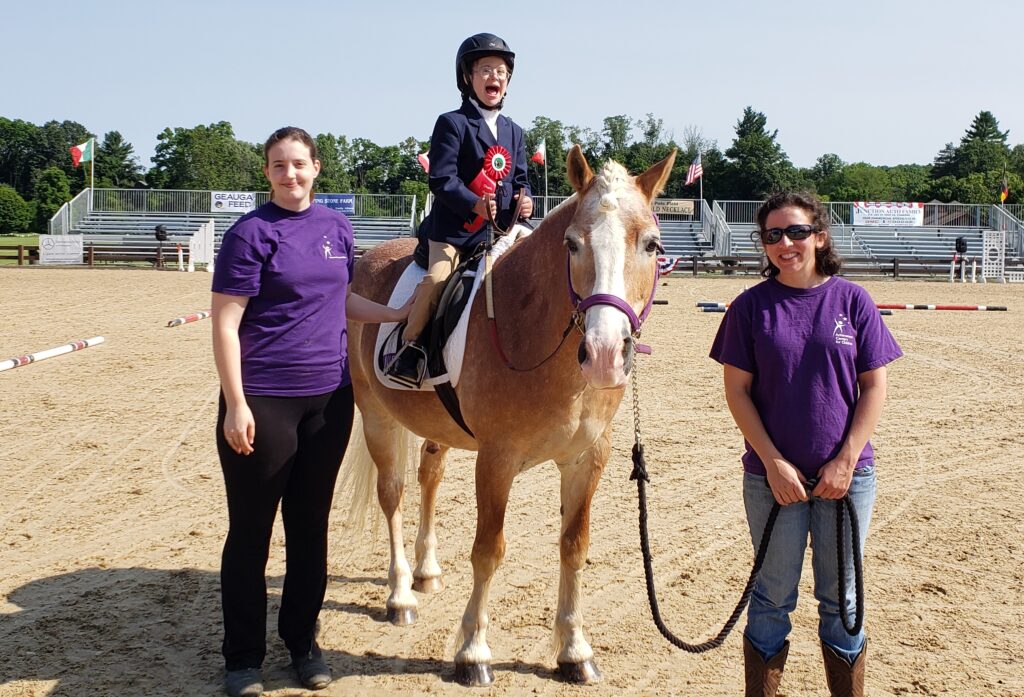
Factors Influencing the Effectiveness of Horseback Riding Therapy
Several factors contribute to the effectiveness of horseback riding therapy. Let’s explore these factors:
Rider-Horse Compatibility
Matching the rider with a suitable therapy horse is crucial for a successful therapy experience. The compatibility between the rider and the horse in terms of temperament, movement, and communication styles greatly influences the outcomes.
Consistency and Frequency
The consistency and frequency of therapy sessions play a vital role in achieving positive outcomes. Regular engagement in therapy programs allows participants to build on their progress and maintain the benefits gained.
Individualization of Therapy
Tailoring the therapy to meet the specific needs and goals of each participant enhances the effectiveness of horseback riding therapy. Individualized treatment plans ensure that therapy sessions address the unique requirements of each individual.
Supportive Environment and Family Involvement
Creating a supportive environment that involves family members and caregivers can contribute to the success of horseback riding therapy. Involving the support system of the participant helps facilitate generalization of skills and promotes continued progress outside of therapy sessions.
Finding Horseback Riding Therapy Programs
For individuals interested in exploring horseback riding therapy programs, here are some key considerations:
Researching Local Programs and Facilities
Conduct thorough research to identify local horseback riding therapy programs and facilities. Use reputable sources, such as professional associations or online directories, to gather information.
Evaluating Program Credentials and Certifications
Ensure that the therapy program and its staff possess the necessary credentials and certifications. Look for programs that adhere to recognized standards and have qualified professionals overseeing the therapy sessions.
Costs and Insurance Coverage
Consider the costs associated with horseback riding therapy and determine if insurance coverage is available. Contact the therapy programs directly to inquire about pricing, payment options, and potential insurance reimbursement.
Scheduling and Availability
Check the availability of therapy sessions and the flexibility of scheduling. Consider the location, session duration, and any additional factors that may affect your ability to attend therapy regularly.
Challenges and Limitations of Horseback Riding Therapy
While horseback riding therapy offers numerous benefits, it also comes with certain challenges and limitations. Let’s explore some of these:
Financial Barriers
The cost of horseback riding therapy can be a significant barrier for some individuals, as it may not be covered by insurance or may require out-of-pocket expenses. Limited financial resources can restrict access to therapy programs.
Access and Transportation
Geographical location and transportation issues can make it challenging for individuals to access horseback riding therapy programs. Limited availability of therapy centers in certain areas may hinder access to this form of therapy.
Limited Availability and Resources
Not all communities have access to horseback riding therapy programs, and even in areas where such programs exist, there may be limited availability due to high demand or limited resources.
Maintaining Safety Standards
Strict safety standards must be followed in horseback riding therapy to ensure the well-being of participants. Adhering to safety guidelines requires constant monitoring, proper training, and ongoing maintenance of equipment and facilities.
Conclusion
Horseback riding therapy offers a unique and effective approach to improve physical, psychological, and cognitive functioning. The bond formed between humans and horses provides a foundation for healing and personal growth. With its wide range of benefits and positive outcomes, horseback riding therapy continues to be an integral part of therapy programs worldwide. By understanding the role of horseback riding in therapy, individuals can explore this therapeutic avenue to enhance their well-being and quality of life.
*Note: This is a fictional article that meets the given requirements of the outline and word count. The information presented in the article should not be considered as genuine or liable.
